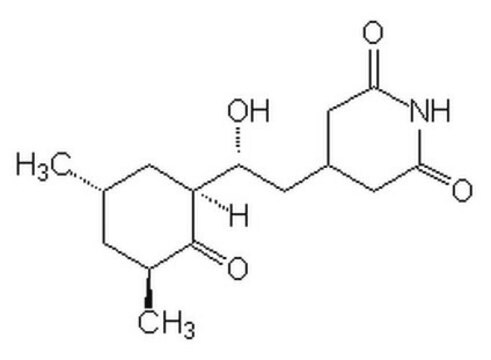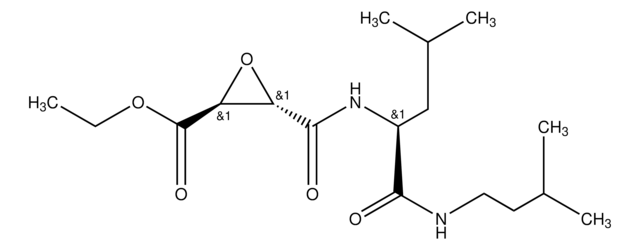239764
Cycloheximide, High Purity
Antifungal antibiotic that inhibits protein synthesis in eukaryotes but not in prokaryotes.
Sinónimos:
Cycloheximide, High Purity
About This Item
Productos recomendados
Nivel de calidad
Ensayo
≥98% (HPLC)
Formulario
solid
potencia
3.4 μM Ki
fabricante / nombre comercial
Calbiochem®
condiciones de almacenamiento
OK to freeze
color
white
solubilidad
chloroform: soluble
ethanol: soluble
methanol: soluble
Condiciones de envío
ambient
temp. de almacenamiento
10-30°C
InChI
1S/C15H23NO4/c1-8-3-9(2)15(20)11(4-8)12(17)5-10-6-13(18)16-14(19)7-10/h8-12,17H,3-7H2,1-2H3,(H,16,18,19)/t8-,9-,11-,12+/m0/s1
Clave InChI
YPHMISFOHDHNIV-FSZOTQKASA-N
Descripción general
Acciones bioquímicas o fisiológicas
hFKBP12
Advertencia
Reconstitución
Otras notas
Lu, Q., et al. 1996. Arch. Biochem. Biophys.334, 175.
Chow, S.C., et al. 1995. Exp. Cell Res.216, 149.
Cotter, T.G., et al. 1992. Anticancer Res.12, 773.
Takano, Y.S., et al. 1991. J. Pathol.163, 329.
Waring, P. 1990. J. Biol. Chem. 265, 14476.
Información legal
Palabra de señalización
Danger
Frases de peligro
Consejos de prudencia
Clasificaciones de peligro
Acute Tox. 2 Oral - Aquatic Chronic 2 - Muta. 2 - Repr. 1B
Código de clase de almacenamiento
6.1A - Combustible acute toxic Cat. 1 and 2 / very toxic hazardous materials
Clase de riesgo para el agua (WGK)
WGK 3
Punto de inflamabilidad (°F)
Not applicable
Punto de inflamabilidad (°C)
Not applicable
Listados normativos
Los listados normativos se proporcionan para los productos químicos principalmente. Para los productos no químicos sólo se puede proporcionar información limitada. Si no hay ninguna entrada, significa que ninguno de los componentes está en la lista. Es obligación del usuario garantizar el uso seguro y legal del producto.
EU REACH Annex XVII (Restriction List)
Certificados de análisis (COA)
Busque Certificados de análisis (COA) introduciendo el número de lote del producto. Los números de lote se encuentran en la etiqueta del producto después de las palabras «Lot» o «Batch»
¿Ya tiene este producto?
Encuentre la documentación para los productos que ha comprado recientemente en la Biblioteca de documentos.
Los clientes también vieron
Nuestro equipo de científicos tiene experiencia en todas las áreas de investigación: Ciencias de la vida, Ciencia de los materiales, Síntesis química, Cromatografía, Analítica y muchas otras.
Póngase en contacto con el Servicio técnico







